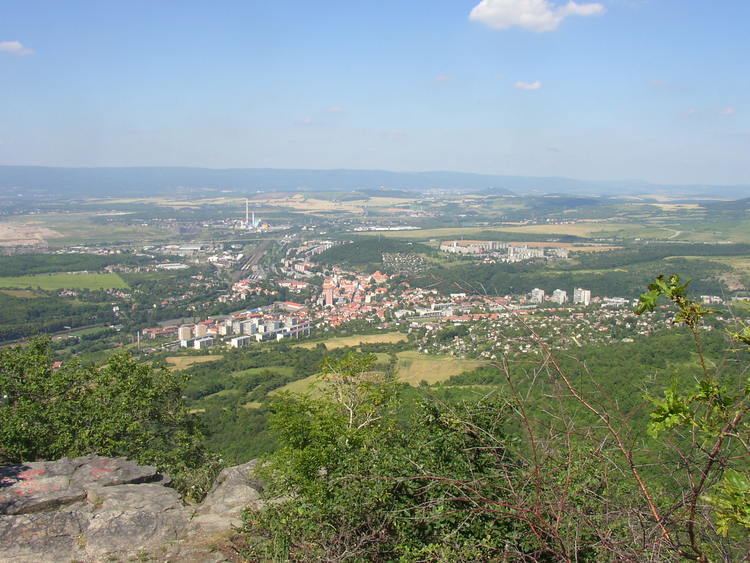- summer (DST) CEST (UTC+2) Area 32.39 km² | Elevation 214 m Local time Thursday 6:40 PM | |
 | ||
Weather 6°C, Wind W at 34 km/h, 59% Humidity Points of interest Bořeň, Městská hradby, Trupelník | ||
4k video lom b lina coal mine bilina czech republic
Bílina ( [ˈbiːlɪna]; German: Bilin) is a town in the Teplice District in the Ústí nad Labem Region of the Czech Republic. It is located on the river Bílina. It is known for its spas and as a source of the strongly mineralized water, Bílinská Kyselka (Biliner Sauerbrunn in German). From 1938 to 1945 it was one of the municipalities in Sudetenland.
Contents
- 4k video lom b lina coal mine bilina czech republic
- Map of BC3ADlina Czechia
- Location
- History
- Blinsk Kyselka mineral springs and Spa
- Places of interest
- Culture and Sport
- Twin towns
- References
Map of B%C3%ADlina, Czechia
Location
The historic town of Bílina lies in the valley of the river Bílina, between the Central Bohemian Massif and the Ore mountains. It is situated between two bigger cities: Teplice and Most.
To the south, the mountain Bořeň, resembles a lying lion.
History
The name of the town originates from the adjective white (bílý; bielý). The term Bielina symbolizes 'white', without any wood or the flowing river Běla.
The first written mention of the settlement (then a seat of a province) dates back to 993 and comes from the Chronicle of Bohemians, which describes a battle between Bretislaus I and the German emperor Henry III near the town.
Before the half of 13th century Ojíř of Friedberk built a new castle in the settlement, which was expanded into a town with bulwarks and three gates.
In the High Middle Ages German settlers were called into the border area of Bohemia, introducing German city law. Germans formed the vast majority, culture and history until their expulsion in 1945.
During 1420 the town of Bílina was kept by Albrecht of Koldice, well known for his anti-Hussite attitude. Thus, Bílina was surrounded and conquered by a Hussite Jakoubek of Vřesovice who returned the town of Bílina to the Koldice dynasty in 1436.
After 1502, the town of Bílina was owned by the House of Lobkowicz, to whom this town was returned to in 1989 during restorations.
Bílinská Kyselka mineral springs and Spa
In 1702 Princess Leonora of the House of Lobkowicz had the mineral spring cleaned and the very first spa guests began to visit. By the end of 19th century the spa Biliner Sauerbrunn (meaning "Carbonated springs from Bílina" in German) had become the pride of the town. Bílina also received the nickname "Vichy of Germany". The digestive pastilles produced here also provided a worldwide common name for digestive regulators and laxatives: "Seidlitz Powders." The lozenges were made from the spring's mineral water Sedlitz bitter water, which was also used in the local spa balneology.
Scientific descriptions of the medicinal properties of local water treatment have contributed to the works of significant balneologists, including Franz Ambrosius Reuss, August Emanuel von Reuss and Josef von Löschner. Father and son Reuss are in the spa Bílina memorial, which dominates the spa's central park.
In 1878 a large spa complex was built in a Renaissance Revival style, designed by the architect Franz Sablick. Thereafter the "Josephs Quelle" spring "temple" became popular, along with the Forest café, which was built as a timber pavilion in Swiss style.
2,225,000 bottles of Bílinská Kyselka mineral water were exported in 1889, the biggest importer being Germany.
Another turning point in the history of spa was a changeover in 1989, after the end of the Communist regime. The House of Lobkowicz regained a part of their original property, including the Spa of Bílinská Kyselka. The spa was later sold to a private company.
Places of interest
Culture and Sport
The town boasts a modern stadium. In the new millennium a new ice-hockey hall was also built. The swimming pool dates from 1931.
Twin towns
Bílina is twinned with
